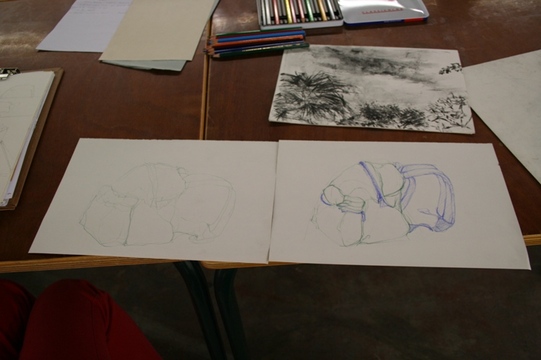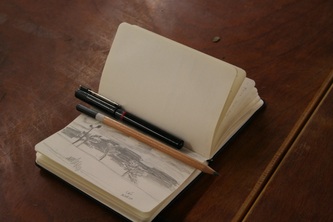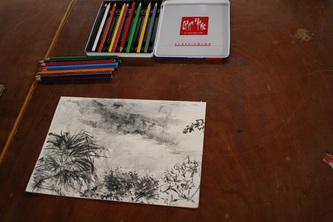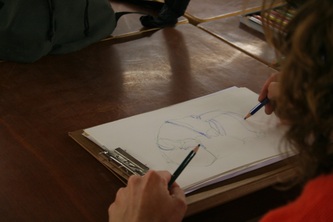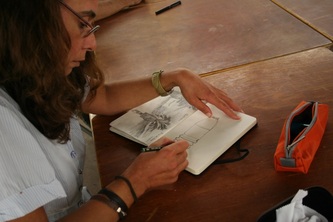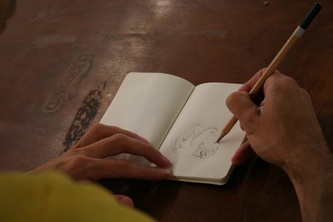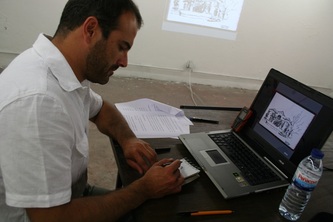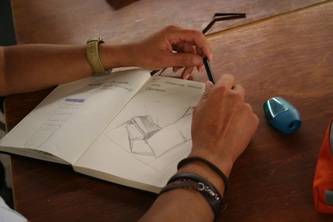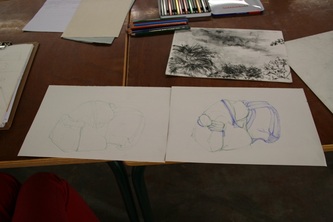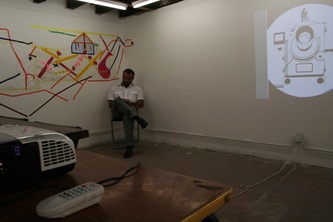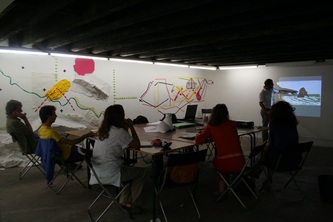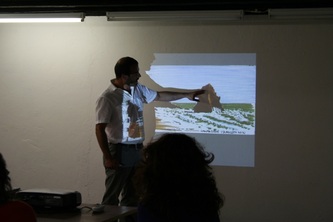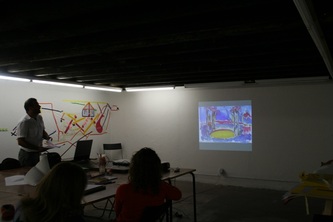_© All rigths reserved to Associação Espaços do
Desenho-Drawing Spaces. Text.Sound.Video.Images
_
Drawing – perception and act
WORKSHOP Developed as PART OF A SERIES OF WORKSHOPS
UNDER THE THEME “8 POSSIBILITIES OF MAKING DRAWING”
Drawing Spaces, Lisbon, Portugal
25 SEPTEMBER 2011
WORKSHOP Developed as PART OF A SERIES OF WORKSHOPS
UNDER THE THEME “8 POSSIBILITIES OF MAKING DRAWING”
Drawing Spaces, Lisbon, Portugal
25 SEPTEMBER 2011
REPORT 15 -
IDEAL
Intercultural Drawing for European Adult Learning
Intercultural Drawing for European Adult Learning
WHAT
Drawing – Perception and Act aimed to explore memory and the processing of visual stimuli through drawing. In other words, participants were introduced to several examples and were encouraged to use drawing as an emulation of the perceptive experience through memory.
WHERE
Drawing Spaces, Fábrica de Braço de Prata, Lisbon, Portugal.
WHEN
25 September 2011, 19h00-23h00
WHO
Facilitators and StafF
Filipe Leal de Faria
Eduardo Salavisa
Teresa Carneiro
ADULT LEARNERS
5 Female and Male participants, with an age range between 25 and 32 years old.
(This workshop was open to anyone)
WHY
This workshop was part of a project which aimed to respond to the dynamics of Drawing Spaces by presenting a series of public workshops coordinated by a variety of experts in the field of drawing. These workshops took place over a period of 2 weeks, during opening hours – from Wednesday to Saturday, from 19h to 23h – following the ‘open residency’ model. This gave the public the opportunity to daily visit and accompany the development of these experimental sessions around drawing.
These series of workshops were designed to extend the public contact with artists and with the specificity of the artist’s modes of working in their personal projects. The artists were asked to develop a workshop that maximized the interaction with the public; it was proposed to the public to participate in more than one of the workshops and to observe the diversity of the artists’ approaches. Drawing – Perception and Act aimed to explore memory and the processing of visual stimuli through drawing. In other words, participants were introduced to several examples and were encouraged to use drawing as an emulation of the perceptive experience through memory.
HOW
VALUE FOR LEARNERS
Participants learned ways in which to associate the drawing act to their visual memory. Participants also learned to distinguish the use of the drawing process as a device to enhance memory from the use of the drawing process as a device to extend the perceptive act. Participants understood that the perceptive act can sometimes be undermined by memory and that therefore one can train the perceptive act to work more with the present or with the past (memory).
VALUE FOR THE FACILITATORS
Facilitators understood how much it helps to try out different propositions along with participants, not only to engage them in the activities, but also to provide them with more confidence to deliver themselves into the discovering process rather than looking for or expecting particular results. In this particular workshop, facilitators learned a lot from participants’ responses as each connected differently to his/her memories, just as much as each was able to disconnect more or less easily from his/her memories to engage more in the perceptive act of drawing. Facilitators also learned how the working environment might change from the number of participants that sign in for an activity. As this workshop had slightly fewer participants than the previous ones, one could note that the working environment was quite calm, relaxing, without any sort of anxieties from the participants, even though this was possibly one of the most conceptual activities from the series of workshops 8 Possibilities of making drawing.
VISUAL RECORDS
Drawing – Perception and Act aimed to explore memory and the processing of visual stimuli through drawing. In other words, participants were introduced to several examples and were encouraged to use drawing as an emulation of the perceptive experience through memory.
WHERE
Drawing Spaces, Fábrica de Braço de Prata, Lisbon, Portugal.
WHEN
25 September 2011, 19h00-23h00
WHO
Facilitators and StafF
Filipe Leal de Faria
Eduardo Salavisa
Teresa Carneiro
ADULT LEARNERS
5 Female and Male participants, with an age range between 25 and 32 years old.
(This workshop was open to anyone)
WHY
This workshop was part of a project which aimed to respond to the dynamics of Drawing Spaces by presenting a series of public workshops coordinated by a variety of experts in the field of drawing. These workshops took place over a period of 2 weeks, during opening hours – from Wednesday to Saturday, from 19h to 23h – following the ‘open residency’ model. This gave the public the opportunity to daily visit and accompany the development of these experimental sessions around drawing.
These series of workshops were designed to extend the public contact with artists and with the specificity of the artist’s modes of working in their personal projects. The artists were asked to develop a workshop that maximized the interaction with the public; it was proposed to the public to participate in more than one of the workshops and to observe the diversity of the artists’ approaches. Drawing – Perception and Act aimed to explore memory and the processing of visual stimuli through drawing. In other words, participants were introduced to several examples and were encouraged to use drawing as an emulation of the perceptive experience through memory.
HOW
- The session started with a short introduction by the invited artist, Filipe Leal de Faria, who has developed a lot of research work and also focuses his drawing practice in memory and the perceptive experience.
- Filipe Leal de Faria showed various examples of his drawings, discussing how the same scene, in this case a beach landscape, could be drawn each time in a different way, depending on the conditions of the environment, but also depending on the conditions of the perceptive moment by the person who was drawing.
- The artist showed an extensive series of drawings on this same subject to discuss ways in which the perceptive act could change unconsciously, and ways in which the perceptive act could change consciously.
- Some work of other artists was also showed and discussed as well as different ideas that have been argued in art theory more recently.
- Participants were then asked to develop various exercises, some recurring directly to memory, others focusing more intensively and consciously on the perceptive moment when participants were drawing, as if looking at something from the first time.
- The artist also drew throughout the session.
- At the end of the session, participants gathered to discuss the outcomes, processes, techniques and how they responded to the ideas of the workshop.
VALUE FOR LEARNERS
Participants learned ways in which to associate the drawing act to their visual memory. Participants also learned to distinguish the use of the drawing process as a device to enhance memory from the use of the drawing process as a device to extend the perceptive act. Participants understood that the perceptive act can sometimes be undermined by memory and that therefore one can train the perceptive act to work more with the present or with the past (memory).
VALUE FOR THE FACILITATORS
Facilitators understood how much it helps to try out different propositions along with participants, not only to engage them in the activities, but also to provide them with more confidence to deliver themselves into the discovering process rather than looking for or expecting particular results. In this particular workshop, facilitators learned a lot from participants’ responses as each connected differently to his/her memories, just as much as each was able to disconnect more or less easily from his/her memories to engage more in the perceptive act of drawing. Facilitators also learned how the working environment might change from the number of participants that sign in for an activity. As this workshop had slightly fewer participants than the previous ones, one could note that the working environment was quite calm, relaxing, without any sort of anxieties from the participants, even though this was possibly one of the most conceptual activities from the series of workshops 8 Possibilities of making drawing.
VISUAL RECORDS
